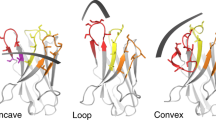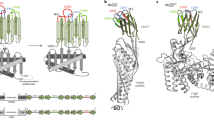Abstract
Small protein domains, capable of specific binding to different target proteins have been selected using combinatorial approaches. These binding proteins, called affibodies, were designed by randomization of 13 solvent-accessible surface residues of a stable α-helical bacterial receptor domain Z, derived from staphylococcal protein A. Repertoires of mutant Z domain genes were assembled and inserted into a phagemid vector adapted for monovalent phage display. Two libraries, each comprising approximately 4 × 107 transformants, were constructed using either an NN(G/T) or an alternative (C/A/G)NN degeneracy. Biopanning against the target proteins Taq DNA polymerase, human insulin, and a human apolipoprotein A-1 variant, showed that in all cases significant enrichments were obtained by the selection procedures. Selected clones were subsequently expressed in Escherichia coli and analyzed by SDS-PAGE, circular dichroism spectroscopy, and binding studies to their respective targets by biospecific interaction analysis. The affibodies have a secondary structure similar to the native Z domain and have micromolar dissociation constants (KD) for their respective targets.
This is a preview of subscription content, access via your institution
Access options
Subscribe to this journal
Receive 12 print issues and online access
$209.00 per year
only $17.42 per issue
Buy this article
- Purchase on Springer Link
- Instant access to full article PDF
Prices may be subject to local taxes which are calculated during checkout
Similar content being viewed by others
References
Clackson, T. and Wells, J.A. 1994. In vitro selection from protein and peptide libraries. Trends Biotechnol. 12: 173–184.
Dunn, I.S. 1996. Phage display of proteins. Curr. Opin. Technol. 7: 547–553.
Pinilla, C., Appel, J., Blondelle, S., Dooley, C., Dorner, B., Eichksr, J. et al. 1995. A review of the utility of soluble peptide combinatorial libraries. Biopolymers. 37: 221–240.
Griffith, A.D., Williams, S.C., Hartley, O., Tomlinson, I.M., Waterhouse, P., Crosby, W.L. et al. 1994. Isolation of high affinity human antibodies directly from large synthetic repertoires. EMBO J. 13: 3245–3260.
Vaughn, T.J., Williams, A.J., Pritchard, K., Osbourn, J.K., Pope, A.R., Earnshaw, J.C. et al. 1996. Human antibodies with sub-nanomolar affinities isolated from a large non-immunized phage display library. Nature Biotechnology 14: 309–314.
Bianchi, E., Folgori, A., Wallace, A., Ncotra, M., Acali, S., Phalipon, A. et al. 1995. A conformationally homogeneous combinatorial peptide library. J. Mol. Biol. 247: 154–160.
Ku, J. and Schultz, P.G. 1995. Alternate protein frameworks for molecular recognition. Proc. Natl. Acad. Sci. USA 92: 6552–6556.
McConnell, S. and Hoess, R.H. 1995. Tendamistat as a scaffold for conformationally constrained phage peptide libraries. J. Mol. Biol. 250: 460–470.
Martin, R., Toniatti, C., Salvatti, A.L., Ciliberto, G., Cortese, R. and Sollazzo, M. 1996. Coupling protein design and in vitro selection strategies: Improving specificity and affinity of a designed β-protein IL-6 antagonist. J. Mol. Biol. 255: 86–97.
Lu, Z., Murray, K.S., Van Cleave, V., LaVallie, E.R., Stahl, M.L. and McCoy, J.M. 1995. Expression of thtoredoxin random peptide libraries on the Escherichia collcell surface as functional fusions to flagellin: a system designed for exploring protein-protein interactions. Bio/Technol. 13: 366–372.
Berkower, I. 1996. The promise and pitfalls of monoclonal antibody therapeutics. Curr. Opin. Biotechnol. 7: 622–628.
Moks, T., Abrahmsén, I., Nilsson, B., Hellman, U., Sjöquist, J. and Uhlén, M. 1986. Staphylococcal protein A consists of five IgG-binding domains. Eur. J. Biochem. 156: 637–643.
Ståhl, S. and Nygren, P. 1997. The use of gene fusions to protein A and protein G in immunology and biotechnology. Path. Biol. 45: 66–76.
Samuelsson, E., Moks, T., Nilsson, B. and Uhlén, M. 1994. Enhanced in vitro refolding of insulin-liki growth factor I using a solubilizing fusion partner. Biochemistry 33: 4207–4211.
Samuelsson, E., Jonasson, P., Viklund, F., Nilsson, B. and Uhlén, M. 1996. Affinity-assisted in vivo folding of a secreted human peptide hormone in Escherichia coli. Nature Biotechnology 14: 751–755.
Olsson, A., Eliasson, L., Guss, B., Nilsson, B., Hellman, U., Lindberg, M. and Uhlén, M. 1987. Structure and evolution of the repetitive gene encoding strepto-coccal protein G. Eur. J. Biochem. 168: 319–324.
Alexander, P., Fahnestock, S., Lee, T., Orban, J. and Bryan, P. 1992. Thermodynamic analysis of the folding of the streptococcal protein G IgG-binding domains B1 and B2: why small proteins tend to have high denaturation temperatures. Biochemistry 31: 3597–3603.
Deisenhofer, J. 1981. Crystallographic refinement and atomic models of human Fc fragment and its complex with fragment B of protein A from Staphylococcus aureusat 2. 9- and 2.8-Å resolution. Biochemistry 20: 2361–2370.
Sauer-Eriksson, E.A., Kleywegt, G.J., Uhlén, M. and Jones, T.A. 1995. Crystal structure of the C2 fragment of streptococcal protein G in complex with the Fc domain of human IgG. Structure 3: 265–278.
Tashiro, M. and Montelione, G.T. 1995. Structures of bacterial immunoglobulin-binding domains and their complexes with immunoglobulins. Curr. Opin. Struct. Biol. 5: 471–481.
Kraulis, P.J., Jonasson, P., Nygren, P., Uhlén, M., Jendeberg, L., Nilsson, B. and Kördel, J. 1996. The serum albumin-binding domain of streptococcal protein G is a three-helical bundle: a heteronuclear NMR study. FEES Letters 378: 190–194.
Jendeberg, L., Persson, B., Andersson, R., Karlsson, R., Uhlén, M. and Nilsson, B. 1995. Kinetic analysis of the interaction between protein A domain variants and human Fc using plasmon resonance detection. J. Molec. Recogntt. 8: 270–278.
Jendeberg, L., Tashiro, M., Tejero, R., Lyons, B.A., Uhlén, M., Montelione, G.T. and Nilsson, B. 1996. The mechanism of binding Staphylococcal protein A to immunoglobin G does not involve helix unwinding. Biochemistry 35: 22–31.
Gouda, H., Torrigoe, H., Saito, A., Sato, M., Arata, Y. and Shimada, I. 1992. Three-dimensional solution structure of the domain B of Staphylococcal protein A: comparisons of the solution and crystal structures. Biochemistry. 31: 9665–9672.
Lyons, B.A., Tashiro, M., Cedergren, L., Nilsson, B. and Montelione, G. 1993. An improved strategy for determining resonance assignments for isotopically enriched proteins and its application to an engineered domain of Staphylococcal protein A. Biochemistry 32: 7839–7845.
Ståhl, S., Nygren, P., Sjölander, A. and Uhlén, M. 1993. Engineered bacterial receptors in immunology. Curr. Opin. Immunol. 5: 272–277.
Nilsson, B., Moks, T., Jansson, B., Abrahmsén, L., Elmblad, A., Holmgren, E. et al. 1987. A synthetic IgG-binding domain based on Staphylococcal protein A. ProtEng. 1: 107–113.
Cedergren, L., Andersson, R., Jansson, B., Uhlén, M. and Nilsson, B. 1993. Mutational analysis of the interaction between Staphylococcal protein A and human IgG,. Prot. Eng. 6: 441–448.
Nord, K., Nilsson, J., Nilsson, B., Uhlén, M. and Nygren, P. 1995. A combinatorial library of an α-helical bacterial receptor domain. Prot. Eng. 8: 601–608.
Djojonegoro, B.M., Benedik, M.J. and Willson, R.C. 1994. Bacteriophage surface display of an immunoglobulin-binding domain of Staphylococcus aureusprotein A. Bio/Technol. 12: 169–172.
Kushawaha, A., Chowdhury, P.S., Arora, K., Abrol, S. and Chaudhary, V.K. 1994. Construction and characterization of Mi3 bacteriophages displaying functional IgG-binding domains of Staphylococcal protein A. Gene 151: 45–51.
Braisted, A.C. and Wells, J.A. 1996. Minimizing a binding domain from protein A. Proc. Natl. Acad. Sci. USA 93: 5688–5692.
Nilsson, J., Bosnes, M., Larsen, R., Nygren, P., Uhlén, M. and Lundeberg, J. 1997. Heat-mediated activation of affinity immobilized TaqDNA polymerase. Biotechniques 22: 744–751.
Calabresi, L., Vecchio, G., Longhi, R., Gianazza, E., Palm, G., Wadensten, H. et al. 1994. Molecular characterization of native and recomblnant apolipoprotein A-lmilano dimer. J. Biol.Chem. 269: 32168–32174.
Nilsson, J., Larsson, M., Ståhl, S., Nygren, P. and Uhlén, M. 1996. Multiple affinity domains for the detection, purification and immobilization of recombinant proteins. J. Molec. Recognit. 9: 585–594.
Richardson, J.H. and Marasco, W.A. 1995. Intracellular antibodies: development and therapeutic potential. Trends Biotechnol. 13: 306–310.
Cunningham, B.C., Lowe, D.G., Li, B., Bennett, B.D. and Wells, J. 1994. Production of an atrial natriuretic peptide variant that is specific for type a receptor. EMBO J. 13: 2508–2515.
Schier, R., Bye, J., Apell, G., McCall, A., Adams, G.P., Malmqvist, M. et al. 1996. Isolation of high-affinity monomeric human anti-c-erbB-2 single chain Fv using affinity-driven selection. J. Mol. Biol. 255: 28–33.
Nilsson, J., Nilsson, P., Witliams, Y., Petterson, L., Uhlén, M. and Nygren, P. 1994. Competitive elution of protein A fusion proteins allows specific recovery under mild conditions. Eur. J. Biochem. 224: 103–108.
Marks, J.D., Griffiths, A.D., Malmqvist, M., Clackson, T.P., Bye, J.M. and Winter, G. 1992. By-passing immunization: building high affinity human antibodies by chain shuffling. Bio/Technol. 10: 779–783.
Martin, F., Toniatti, C., Salvati, A.L., Venturini, S., Ciliberto, G., Cortese, R. and Sollazzo, M. 1994. The affinity-selection of a minibody polypeptide inhibitor of human interleukin-6. EMBO J. 13: 5303–5309.
Markland, W., Ley, C., Lee, S.W. and Ladner, R.C. 1996. Iterative optimization of high-affinity protease inhibitors using phage display. 1. Plasmin. Biochemistry 35: 8045–8057.
Markland, W., Ley, C. and Ladner, R.C. 1996. Iterative optimization of high-affinity protease inhibitors using phage display. 2.Plasma kallikrein and thrombin. Biochemistry 35: 8058–8067.
Holliger, P., Prospero, T. and Winter, G., 1993. “Diabodies”: small bivalent and bispecific antibody fragments. Proc. Natl. Acad. Sci. USA 90: 6444–6448.
Nygren, P.-Å, Flodby, P., Andersson, R., Wigzell, H. and Uhlén, M. 1991. In vivo stabilization of a human recombinant CD4 derivative by fusion to a serum-albumin-binding receptor, pp. 363–368 in Vaccines 97. Chanock, R.M., Ginsberg, H.S., Brown, F., and Lerner, R.A. (eds.) Cold Spring Harbor, Cold Spring, New York.
Makrides, S., Nygren, P., Andrews, B., Ford, P., Evans, K.S., Hayman, E.G. et al. 1996. Extended in vivo half-life of human soluble complement receptor type I fused to serum albumin-binding receptor. J. Pharm. Exp. Therap. 277: 534–540.
Rüther, U. 1982. pUR 250 allows rapid chemical sequencing of both strands of inserts. Nucleic Acid Research 10: 5765–5772.
Maurer, R., Meyer, B.J. and Ptashne, M. 1980. Gene regulation at the right operator (On) of bacteriophage lambda. —I. OR3 and autogenous negative control by represser. J. Mol. Biol. 139: 147–161.
Dower, W.J., Miller, J.F. and Ragsdale, C.W. 1988. High efficiency transformation of E. coli by high voltage electroporation. Nucleic Add Res. 16: 6127–6145.
Hultman, T., Ståhl, S., Homes, E. and Uhlén, M. 1989. Direct solid phase sequencing of genomic and plasmid DNA using magnetic beads as solid support. Nucleic Acids Res. 17: 4937–4946.
Gräslund, T., Nilsson, J., Lindberg, A.M., Uhlén, M. and Nygren, P.-Å 1997. Production of a thermostable DNA polymerase by site-specific cleavage of a heat-eluted affinity fusion protein. Protein Expression and Purification 9: 125–132.
Author information
Authors and Affiliations
Rights and permissions
About this article
Cite this article
Nord, K., Gunneriusson, E., Ringdahl, J. et al. Binding proteins selected from combinatorial libraries of an α-helical bacterial receptor domain. Nat Biotechnol 15, 772–777 (1997). https://doi.org/10.1038/nbt0897-772
Received:
Accepted:
Issue Date:
DOI: https://doi.org/10.1038/nbt0897-772
This article is cited by
-
Adaptable, turn-on maturation (ATOM) fluorescent biosensors for multiplexed detection in cells
Nature Methods (2023)
-
Engineering Saccharomyces cerevisiae for the production and secretion of Affibody molecules
Microbial Cell Factories (2022)
-
A red light–responsive photoswitch for deep tissue optogenetics
Nature Biotechnology (2022)
-
Transferrin Receptor Binding BBB-Shuttle Facilitates Brain Delivery of Anti-Aβ-Affibodies
Pharmaceutical Research (2022)
-
Self-Assembled Nanomicelles of Affibody-Drug Conjugate with Excellent Therapeutic Property to Cure Ovary and Breast Cancers
Nano-Micro Letters (2022)



